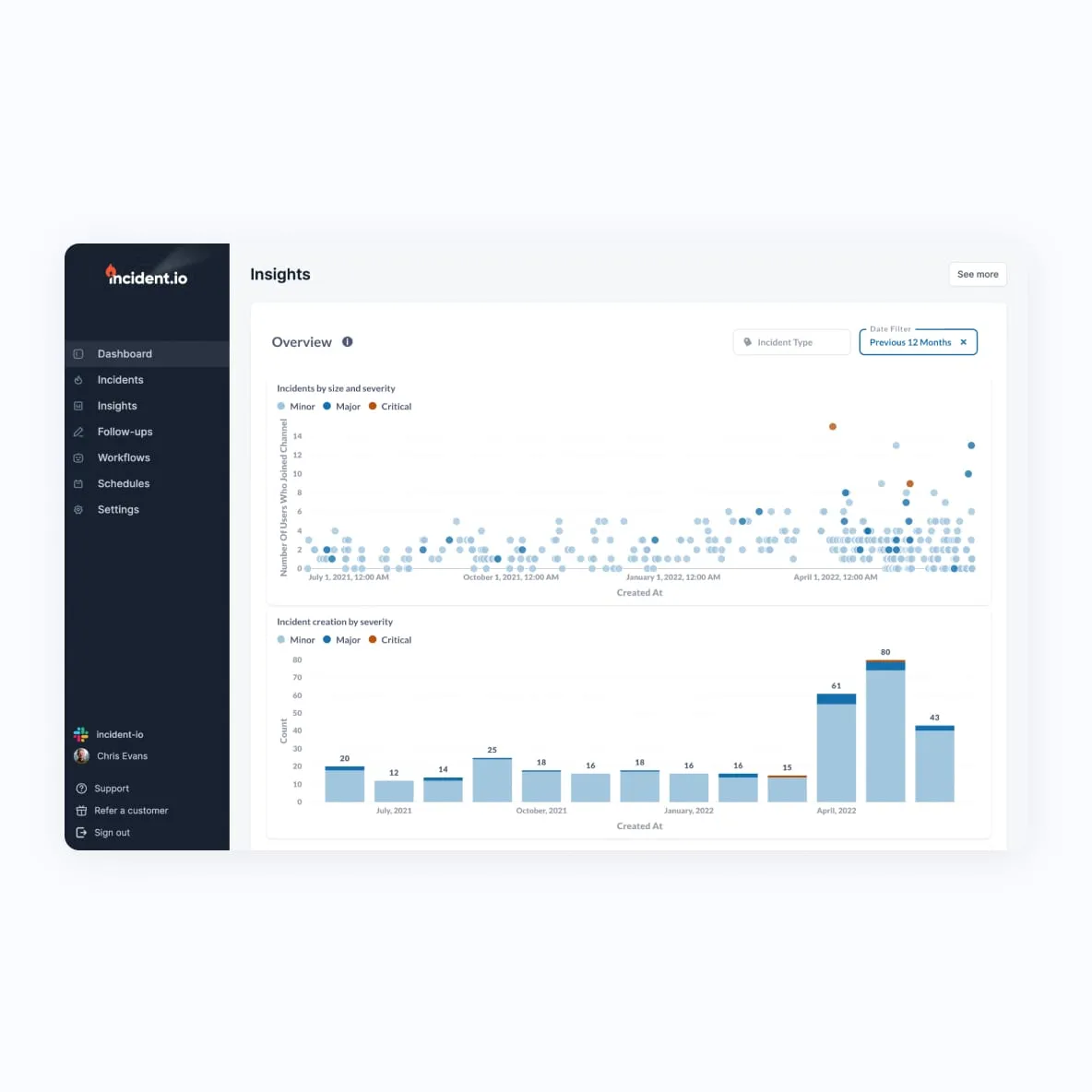Embed charts faster than picking a charting library
Quicker, easier, and cheaper than hacking together a chart.js solution you’ll have to upgrade in six months. Plug in your data source and create unlimited data visualizations to embed into your product or app in a snippet.
Easier than ECharts
Set up with a simple workflow - no Javascript or API endpoints required. Connect to your datasets and go from zero to graph in minutes.
Open source charting solution
Transparent, trustworthy open source software known for its ease of use, with broad data source compatibility. Follow the GitHub stars.
SOC 2 Type II Compliant
Enterprise-level compliance with a price tag that makes sense for startups. Guide your customers to data-driven decisions on their own terms.
Data visualization and chart types that are fast to prototype, fast to implement, fast to iterate
Embed charts with Metabase lets you apply the querying power of BI to your data source. Create visualizations in a flash and add them to your product in just a snippet.
- Launch faster than you can pick a charting library or connect to an API. Have your first visualizations in production before lunchtime.
- Bar charts, pie charts, line charts, combo bar and line charts, maps, and more. Metabase comes with more than 15 chart types to present your data and add to your app or site.
- Need a change? No problem. Quickly update queries, define custom click behavior, and more—all within Metabase's interface. No backend engineering, Python charming, React wrangling, or CSS. Customize charts with nothing but clicks.
Can your charting library do this?
Customer-facing analytics that scales with you. Go beyond iframes and charts and get the jump on your product's growth. Keep up with increasing volumes of data, customers, and reporting needs.
- Interactive, responsive charts. Include tooltips with metadata and context, or go even further and let customers drill down on data points that interest them.
- Made to match. Tweak colors, labels, fonts, and more, for a seamless fit with your brand and product for a best-in-class user experience.
- Creating new dashboards from each customer's feedback? Let them self-serve analytics and reports with easy-to-use functionality for all people and use cases. No SQL required or even HTML.
- Give customers granular data access and permissions. With single sign-on access and row- and column-level permissions.

Help from our world-class success team
We don't like to brag, so we'll let our customers do it for us.
With cloud-hosted embedding, you'll get access to:
- Support from actual technical experts. We're all avid Metabase users who are well versed in business analytics and business intelligence platforms, so we've been in your shoes.
- Help with whatever your problem is, be it admin troubleshooting or advice on best practices on everything from data analysis, frameworks, tutorials, demos, structuring your datasets, embedding in apps, real-time data modeling, and more.
- No chatbots, no hold lines, no customer service runaround. Just email us, we're right here.
“The expertise and engagement of the Metabase team stands in stark contrast to that which we've received from Looker over the past 18+ months and, in previous lives, Tableau.”


“10/10. Metabase support is the best in the industry and serves as a shining example of what we try to achieve for our own customers.”


“Johannes is a world class support engineer. I really give him 5 stars for the help he provided. All responses were very fast, to the point, and helpful. I couldn't ask for better support. A true expert.”


“I got excellent and timely response to my question. Thank you for the level of detail you provided, you made me feel that if we migrate our installation to your cloud service, we will have your support.”


“Johannes is the best! He always gives thorough responses and next steps that help us manage expectations with our end users.”


“I really appreciated how fast Luis was to respond, and how straightforward his recommendations are. You're awesome!”


“The response was specific on all my raised points and it came back very quickly!”


“The expertise and engagement of the Metabase team stands in stark contrast to that which we've received from Looker over the past 18+ months and, in previous lives, Tableau.”


“10/10. Metabase support is the best in the industry and serves as a shining example of what we try to achieve for our own customers.”


“Johannes is a world class support engineer. I really give him 5 stars for the help he provided. All responses were very fast, to the point, and helpful. I couldn't ask for better support. A true expert.”


“I got excellent and timely response to my question. Thank you for the level of detail you provided, you made me feel that if we migrate our installation to your cloud service, we will have your support.”


“Johannes is the best! He always gives thorough responses and next steps that help us manage expectations with our end users.”


“I really appreciated how fast Luis was to respond, and how straightforward his recommendations are. You're awesome!”


“The response was specific on all my raised points and it came back very quickly!”


What makes Metabase a good choice for embedding charts and analytics?
There's a time and place for charting libraries. But if you're looking for an excellent user experience with none of the heavy lifting, we think you're going to like what you find with Metabase.
| Charting libraries | Metabase | |
|---|---|---|
| Unlimited questions | ||
| Unlimited charts and graphs | ||
| Extensive visualization types | ||
| Fast, code-free edits | ||
| Interactive charts | ||
| White-label to fit your brand | ||
| Connects to 20+ data sources, including CSV upload | ||
| Unlimited technical help | ||
| Secure and scalable | ||
| Regular updates and improvements |

Frequently asked questions
We compared the most popular open source charting libraries in this blog post, including Echarts, chart.js, Plotly, Nivo, Visx. You can also look beyond Javascript charting libraries at things like Rechart, built with React and d3.js; and Angular data visualization and charting libraries like ngx. A tool like Highcharts lets developers create charts with Javascript, Angular, React, Vue.js, iOS, R, NET, Python and more.
Visualization libraries are a good option if you’re already deep into component-driven development or have a skilled dev team on hand that can quickly implement and iterate on charts.However, as you scale, maintaining a visualization library can mean taking on a lot of overhead. For example:
- If you outgrow your visualization library in any way, you’ll either need to work with maintainers to add new features or fixes, or pivot to an entirely new visualization library.
- Your dev team will need to handle ad-hoc requests for embedding and charting, or you’ll have to find a middle ground, like adding new interfaces and platforms to support teams that aren’t as familiar with a visualization library.
In these scenarios, using a Business Intelligence (BI) tool like Metabase that has features to support both technical and non-technical teams can save you down the line.
Embedded analytics platforms let you integrate the best of Business intelligence (BI tools) and functionality into your software app, product, or website. They’re designed to query and visualize data into actionable insights, made accessible to your customers and business users. They do this by:
- Analyzing and summarizing data - embedded BI tools can identify patterns, trends, and relationships within your data.
- Creating visualizations - They can present this information in easy-to-understand formats like charts, graphs, and dashboards.
- Static or interactive chart types - Let customers filter, click-through, or drill down on data points of interest. Or keep it lightweight and static.
- Facilitating forecasting - These tools can help predict future trends based on historical data.
Overall, embedded BI empowers your customers to make data-driven decisions.
Embedded analytics solutions allow you to put your customers’ data - and datasets that are relevant to them - in front of them, with as much or as little analytics functionality as you want. Without investing countless months and resources into building your own analytics solution. Many startups through to enterprise level companies use embedded analytics to get to proof of concept in just a couple of weeks, and work with people who build analytics solutions for a living so they can focus on the goals of their business.
There’s no right or wrong answers here. It will generally depend on your use case, how much you want your customers and end users to be able to learn from data and run reports on their own without depending on your data team; your preferred data stack, how fast you need to get up and running, your budget, and more.
Again, there’s no “right” answer, but just sayin’ - Metabase is user-friendly to let everyone on your team get real-time insights from data. It works well with all of your datasets and preferred data tools (from data sources, data preparation, and semantic layering tools). It gets up and running in 5 minutes flat. And pricing is suited to all budgets (and you can try it for free).
Teams who have used Tableau, Microsoft’s Power BI, Google’s Looker, Domo, Sisense, Sigma and other embedded BI platforms now choose Metabase as it lets their customers and business users self-service analytics. User-friendly drag-and-drop data analytics lets people run ad hoc reports on their own and get actionable insights without needing SQL or a data analytst.
Metabase is trusted by over 90,000 companies with their data analytics, from startups who need their first business intelligence tool for internal or embedded analytics, through to Enterprises with large datasets, sophisticated use cases, and significant end users.
Metabase open source is the go-to choice for founders and solo-developers to let their teams get answers from data on their own so they’re not running the same reports once a month. Metabase Pro and Enterprise is generally chosen by CTOs, CPOs, Heads of Data who have been there, done that with every other BI platform on the market and need a way to make self-service analytics actually happen.
You’ll have to take our word on this one, but Metabase is even used by several of our competitors (who have asked us not to show their logos, of course). Could we even make that up?
Yes, you can use Metabase for data analysis with Excel or Google Sheets. Here’s how:
- Upload CSV data to Metabase - Combine spreadsheet data with datasets in connected tables and data warehouses. It’s big data meets little data.
- Export Data - Use Metabase to query your data and then export the results directly to Excel or CSV format.
- Google Sheets Integration - Utilize third-party tools like the Metabase integration for Google Sheets to sync query results directly into your spreadsheets.
- API Access - Leverage Metabase’s API to automate data extraction into Excel or Google Sheets for dynamic updates.
- Scheduled Reports - Set up scheduled email reports from Metabase, sending query results to your inbox, which can be easily imported into Excel or Google Sheets.
Metabase’s capabilities in uploading data, exporting data, using third-party integrations, and providing API access make it flexible for combining powerful data analysis with familiar spreadsheet tools.
Ready to get started?
Metabase was the embedded solution we were looking for: easy-to-integrate, customizable and performant.








